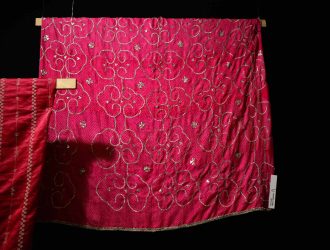This image gallery presents examples of some major traditions of Embroidered textiles.
The focus here is on the north and west of the country–Kashmir, Gujarat and Rajasthan–which are especially rich in embroidery.
Embroidered textiles can be divided on the basis of technique, regional variations, and on the basis of community.
In terms of technique, embroidered textiles may be divided into three basic categories: counting threads, where stitches are placed on the cloth after counting warp and/or weft threads (examples are Toda embroidery of Tamil Nadu, Dongria Kondh embroidery of Odisha, most of the Phulkari traditions of Punjab, Suf embroidery of Kutch, Gujarat, Kasuti embroidery of Karnataka); tracing patterns, where the outlines of the design are first put on the cloth by drawing or tracing or printing (examples are Sozani embroidery Kashmir, Chikankari of Uttar Pradesh, Chamba Rumaal of Himachal Pradesh); free flow patterns, where the motifs are rendered in a more spontaneous manner (examples are some types of Kantha embroidery of Bengal, Sujani embroidery of Bihar).
It is interesting to note that where the embroidery is associated with a region, it is done by any community in that region. Chikankari of Uttar Pradesh or Kantha of Bengal are examples of such traditions. On the other hand, community-based embroidery–typical of most of the embroideries of the Kutch region in Gujarat, for example–have such strong markers of identity and status, that they tend to remain within the community. Community embroidery is also predominantly a women's activity. In many tribal communities, embroidered garments often constitute bridal wealth. Where embroidery is a commercial activity however, it is often done by men, as for example in Kashmir Sozani embroidery, and in traditions like Zardozi embroidery.

















